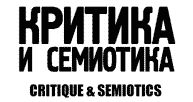VISUAL AS AN ELEMENT OF THE AUTHOR’S CODE IN THE POETICS OF MODERN NOVEL
The article is devoted to the study of the functions of visual codes in verbal discourse. The problem of the codes of photography and cinema in the plot and the composition of the novel discusses on the basis of the modern Russian prose, the status of the visual in the narrative, the interaction of visual and verbal as a feature of the poetics of the modern Russian novel reveals. The use of the visual in the narrative of the novel is associated with the production of existential problems and serves to increase the semantic density of the plot, open in history. Update the language of literary text is due to the attraction of terms of photography and cinema, as metaphors of existence, these language elements begin to define the structure of the narrative.
Keywords: visual code, fiction narrative, modern Russian prose, poetics, composition, photography, cinema
References:
Eco 2006 – Eco U. To say almost the same thing. Experiments on translation. Translation into Russian. Saint-Petersburg, 2006.
Freilikh 2002 – Freilikh S. The theory of cinema from Eisenstein to Tarkovsky. Moscow, 2002. In Russian.
Inishev 2014 – Inishev I. N. Phenomenological hermeneutics in the media-theoretical perspective. Questions of philosophy. 2014. 3. URL: http://vphil.ru/index.php?id=927&Itemid=52&option=com_content&task=view. In Russian.
Krieger 1992 – Krieger M. Ekphrasis: The Illusion of the Natural Sign. Baltimore: Johns Hopkins University Press, 1992.
Kuvshinova 2014 – Kuvshinova M. Cinema as a visual code. Moscow, 2014. In Russian.
Martianova 2002 – Martianova I. A. Film-century of russian text: the paradox of literary cinematography. Saint-Petersburg, 2002. In Russian.
Polyanskaya 1999 – Polyanskaya I. Reading water. New world. 1999. 10. In Russian.
Tokarev 2013 – ”Indescribably expressible”. Ekphrasis and problems of representation of visual in a literary text. Ed. by D. B. Tokarev. Moscow, 2013. In Russian.
Tretyakov 2009 – Tretyakov E. N. Ekphrasis as matrix representation of figurative signs. The dissertation for the degree of candidate of philological sciences. Tver, 2009. URL: http://www.dslib.net/jazyko-znanie/jekfrasis-kak-matrichnaja-reprezentacija-obraznyh-znakov.html. In Russian.
Issue: 2, 2015
Series of issue: Issue 4
Rubric: ARTICLES
Pages: 94 — 102
Downloads: 887










